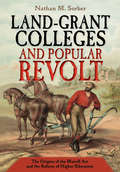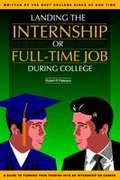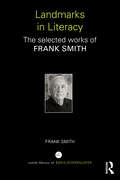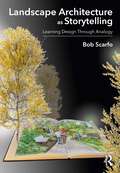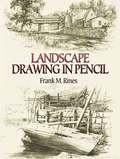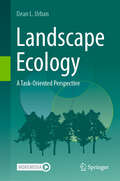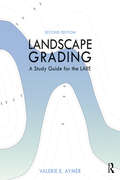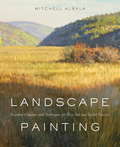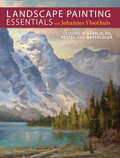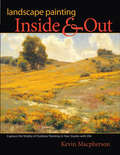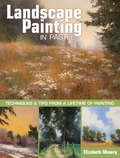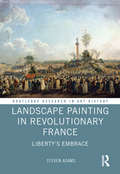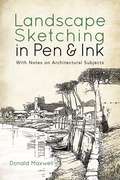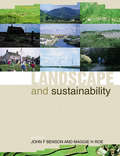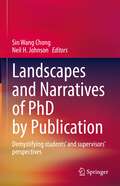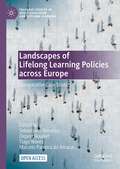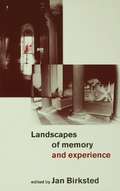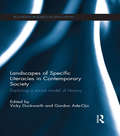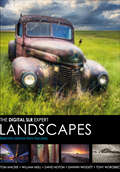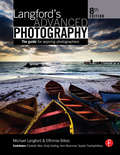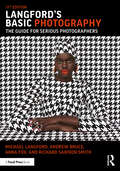- Table View
- List View
Land-Grant Colleges and Popular Revolt: The Origins of the Morrill Act and the Reform of Higher Education
by Nathan M. SorberThe land-grant ideal at the foundation of many institutions of higher learning promotes the sharing of higher education, science, and technical knowledge with local communities. This democratic and utilitarian mission, Nathan M. Sorber shows, has always been subject to heated debate regarding the motivations and goals of land-grant institutions. In Land-Grant Colleges and Popular Revolt, Sorber uncovers the intersection of class interest and economic context, and its influence on the origins, development, and standardization of land-grant colleges.The first land-grant colleges supported by the Morrill Act of 1862 assumed a role in facilitating the rise of a capitalist, industrial economy and a modern, bureaucratized nation-state. The new land-grant colleges contributed ideas, technologies, and technical specialists that supported emerging industries. During the populist revolts chronicled by Sorber, the land-grant colleges became a battleground for resisting many aspects of this transition to modernity. An awakened agricultural population challenged the movement of people and power from the rural periphery to urban centers and worked to reform land-grant colleges to serve the political and economic needs of rural communities. These populists embraced their vocational, open-access land-grant model as a bulwark against the outmigration of rural youth from the countryside, and as a vehicle for preserving the farm, the farmer, and the local community at the center of American democracy.Sorber's history of the movement and society of the time provides an original framework for understanding the origins of the land-grant colleges and the nationwide development of these schools into the twentieth century.
Land-Grant Universities for the Future: Higher Education for the Public Good
by E. Gordon Gee Stephen M. GavazziLand-grant colleges and universities have a storied past. This book looks at their future.Land-grant colleges and universities occupy a special place in the landscape of American higher education. Publicly funded agricultural and technical educational institutions were first founded in the mid-nineteenth century with the Morrill Act, which established land grants to support these schools. They include such prominent names as Cornell, Maryland, Michigan State, MIT, Ohio State, Penn State, Rutgers, Texas A&M, West Virginia University, Wisconsin, and the University of California—in other words, four dozen of the largest and best public universities in America. Add to this a number of historically black colleges and universities (HBCUs) and tribal colleges—in all, almost 300 institutions. Their mission is a democratic and pragmatic one: to bring science, technology, agriculture, and the arts to the American people.In this book, Stephen M. Gavazzi and E. Gordon Gee discuss present challenges to and future opportunities for these institutions. Drawing on interviews with 27 college presidents and chancellors, Gavazzi and Gee explore the strengths and weaknesses of land-grant universities while examining the changing threats they face. Arguing that the land-grant university of the twenty-first century is responsible to a wide range of constituencies, the authors also pay specific attention to the ways these universities meet the needs of the communities they serve. Ultimately, the book suggests that leaders and supporters should become more fiercely land-grant in their orientation; that is, they should work to more vigorously uphold their community-focused missions through teaching, research, and service-oriented activities.Combining extensive research with Gee’s own decades of leadership experience, Land-Grant Universities for the Future argues that these schools are the engine of higher education in America—and perhaps democracy’s best hope. This book should be of great interest to faculty members and students, as well as those parents, legislators, policymakers, and other area stakeholders who have a vested interest in the well-being of America’s original public universities.
Landing the Internship or Full-Time Job During College
by Robert R. PetersonThis book will be a game-changer for young professionals. While there is indeed a dearth of career books crowding the shelves at the bookstores and readily available from Amazon or Google searches, most are written by hiring managers and human resources professionals who graduated from college and graduate school decades ago. This book is different, because it is written by young bright minds who have recently made the transition from college to bright careers."-David Samuel, IBM industry executive Landing the Internship or Full-Time Job During College is a collection of the secrets of those who have mastered career mobility. Author Robert R. Peterson interviewed more than twenty rising stars from Fortune 100 companies to amass how to engage the attention of prospective employers. Their experiences are profiled after each chapter, offering an inside look at the process each interviewee took to achieve their goals. From crafting a resume to comparing offer letters, it's all here- straight from those who have recently landed their dream jobs. Let their accomplishments propel you on the path to career success!
Landmarks in Literacy: The Selected Works of Frank Smith
by Frank SmithFrank Smith is internationally acclaimed as an essential contributor to research on the nature of reading and as an originator of the modern psycholinguistic approach to reading instruction. In his publications his aim has always been to support teachers, to encourage them to make teaching decisions based on knowledge and understanding, to analyze what their students are trying to do and why what the students are doing doesn’t always correspond with what they are expected to do. Now the major topics addressed in his work are available in one volume, Landmarks in Literacy, a thoughtfully crafted selection of 16 of his key writings. In the World Library of Educationalists, international scholars themselves compile career-long collections of what they judge to be their finest works so the world can read them in a single manageable volume. Readers thus are able to follow the themes and strands of their work and see their contribution to the development of a field, as well as the development of the field itself.
Landmarks in the History of Physical Education
by P C McIntoshOriginally published in 1957,the first part of this volume examines physical education in classical Greece and Imperial Rome during the first and second centuries A.D. and in Italy and England during the Renaissance. Each of these periods witnessed remarkable developments in the practice and theory of physical education: developments which still have present-day significance. The second part of the book traces the simultaneous development of physical education in different parts of the USA and Europe from the end of the eighteenth century onwards.
Landscape Architecture as Storytelling: Learning Design Through Analogy
by Bob ScarfoThis book introduces students, practitioners, and laypeople to a comfortable approach to learning landscape architectural design free of design jargon and derived from their existing knowledge. A step-by-step process has readers consider their knowledge of language as metaphorically related to basic design and landscape design. Through information delivery and questioning processes, readers build on what they already know, their tacit understanding of language as applied to problem solving and storytelling. Everyone is a storyteller. Taken one step at a time through a three-tiered analogy of language, basic design, and landscape design, readers learn the makeup and role of such design features as points, lines, planes, volumes and sequential volumetric spaces that make up their worlds. With that, in a sense, new world view, and numerous questions and examples, readers begin to see that they in fact daily read the environments in which they live, work, play, raise families, and grow old. Once they realize how they read their surroundings they are helped to recognize that they can build narratives into their surroundings. At that point the existence of authored landscape narratives finds readers understanding a design process that relies on the designer-as-author, landscape-as-text, and participant, user-as-reader. That process has the reader write a first- or second-person narrative, visually interpret the written narrative into a storyboard, and turn the storyboard into a final design, the physical makeup of which is read by those who participate in it.
Landscape Drawing in Pencil (Dover Art Instruction Ser.)
by Frank M. RinesConcise and beautifully illustrated, this guide provides invaluable instruction on the art of pencil drawing. It covers the basics of holding the pencil, applying different strokes, shading, perspective, and the rendering of different textures, as well as the finer points of pictorial composition and drawing from nature.Based on the author's years of experience teaching art students at all levels, this book is ideal for home or class use. Its thirty-six evocative sketches range from English castles to American bridges, with a few detailed close-ups showing how to surmount some of the problems of depicting rocks, roofs, standing water, or leafy tree branches. The accompanying text describes how artists at every level of experience can develop their own pencil technique by employing fundamental rules.
Landscape Ecology: A Task-Oriented Perspective
by Dean L UrbanThis is methods/tools textbook that covers the fundamental tasks in research and management at the landscape scale. It brings together tools from a range of disciplines and presents them in a natural workflow that a practitioner can appreciate. Alternative texts cover a narrower range of topics and/or present the information without reference to a natural workflow. The book begins with 2 fundamental applications that introduce the scope and challenges of working at the landscape scales (sampling design and species distribution modeling). These motivate several chapters that ‘digress’ to cover the primary tools that ecologists use to work with multivariate and spatial data. The book then returns to applications including site prioritization, interpreting (and forecasting) landscape change, and integrated assessment. The tasks themselves follow a logical workflow of collecting and analyzing data, applying the analyses to management decisions, and interpreting the outcomes of these decisions in an integrated framework. This book stems from two graduate-level courses in Landscape Ecology taught at the Nicholas School of the Environment at Duke University. The subject has evolved over time, from a concepts-based overview of what landscape ecology is, to a more applied practicum on how one does landscape ecology. As landscape ecology has matured as a discipline, its perspectives on spatial heterogeneity and scale have begun to permeate into a wide range of other fields including conservation biology, ecosystem management, and ecological restoration. Thus, this textbook will bring students from diverse backgrounds to a common level of understanding and will prepare them with the practical knowledge for a career in conservation and ecosystem management.
Landscape Grading: A Study Guide for the LARE
by Valerie E. AymerFor every element that we design in the landscape, there is a corresponding grading concept, and how these concepts are drawn together is what creates a site grading plan. This study guide explores these concepts in detail to help you learn how to grade with confidence in preparation for the Grading, Drainage and Construction Documentation section of the Landscape Architecture Registration Examination (LARE). This updated second edition is designed as a textbook for the landscape architecture student, a study guide for the professional studying for the LARE, and a refresher for licensed landscape architects. New to this edition: • Additional illustrations and explanations for grading plane surfaces and warped planes, swales, berms, retention ponds, and drain inlets; • Additional illustrations and explanations for grading paths, ramp landings, ramp/stair combinations and retaining walls; • A section on landscape and built element combinations, highlighting grading techniques for parking lots, culverts and sloping berms; • A section on landscape grading standards, recognizing soil cut and fill, determining pipe cover, finding FFE, and horizontal and vertical curves; • Updated information about the computer-based LARE test; • All sections updated to comply with current ADA guidelines; • An appendix highlighting metric standards and guidelines for accessibility design in Canada and the UK. With 223 original illustrations to aid the reader in understanding the grading concepts, including 32 end-of-chapter exercises and solutions to practice the concepts introduced in each chapter, and 10 grading vignettes that combine different concepts into more robust exercises, mimicking the difficulty level of questions on the LARE, this book is your comprehensive guide to landscape grading.
Landscape Painting (PE): Essential Concepts and Techniques for Plein Air and Studio Practice
by Mitchell AlbalaBecause nature is so expansive and complex, so varied in its range of light, landscape painters often have to look further and more deeply to find form and structure, value patterns, and an organized arrangement of shapes. In Landscape Painting, Mitchell Albala shares his concepts and practices for translating nature's grandeur, complexity, and color dynamics into convincing representations of space and light. Concise, practical, and inspirational, Landscape Painting focuses on the greatest challenges for the landscape artist, such as: • Simplification and Massing: Learn to reduce nature's complexity by looking beneath the surface of a subject to discover the form's basic masses and shapes.• Color and Light: Explore color theory as it specifically applies to the landscape, and learn the various strategies painters use to capture the illusion of natural light.• Selection and Composition: Learn to select wisely from nature's vast panorama. Albala shows you the essential cues to look for and how to find the most promising subject from a world of possibilities. The lessons in Landscape Painting—based on observation rather than imitation and applicable to both plein air and studio practice—are accompanied by painting examples, demonstrations, photographs, and diagrams. Illustrations draw from the work of more than 40 contemporary artists and such masters of landscape painting as John Constable, Sanford Gifford, and Claude Monet. Based on Albala's 25 years of experience and the proven methods taught at his successful plein air workshops, this in-depth guide to all aspects of landscape painting is a must-have for anyone getting started in the genre, as well as more experienced practitioners who want to hone their skills or learn new perspectives.
Landscape Painting Essentials with Johannes Vloothuis: Lessons in Acrylic, Oil, Pastel and Watercolor
by Johannes VloothuisSecrets to Painting Beautiful LandscapesPainting the landscape can be fun and rewarding--if you make the right decisions as you paint. After all, it is the artist's greatest challenge to somehow capture a sense of it all--the grandness, the majesty, the splendor of nature--with just a few strokes of paint on a canvas. Popular art instructor Johannes Vloothuis makes the process a whole lot easier with the essential techniques, key concepts and expert advice he shares in this book.Learn straightforward strategies to make your paintings more interesting and dramatic, such as simplifying the foreground, composing with abstract shapes and harmonizing colors.Discover speci?c techniques for painting landscape elements including mountains, water, foliage, snow and more.9 step-by-step demonstrations walk you through all the techniques necessary to create successful landscape paintings.Landscape Painting Essentials is packed with practical information. You'll make the critical shift from painting what you see to painting as an artist sees. You'll learn to strategically edit shapes, rearrange elements and enhance color. You'll gain a better understanding of what to include in your painting, what to change and what to leave out. Most importantly, you'll gain the skills necessary to turn nature's bounty of inspiration into original, stunning landscape paintings.
Landscape Painting Inside and Out: Capture the Vitality of Outdoor Painting in Your Studio with Oils
by Kevin MacphersonPaint with passion, purpose and pleasure What do you want your landscape painting to say about this place, this moment? How do you use the visual vocabulary - line, shape, value, color, edges - to say it? With this book, your conversation with nature will direct your brush. With an exhilarating, synergistic combination of indoor and outdoor painting, Kevin Macpherson shows you how to create personal, poetic landscapes that capture the feeling of being there.Learn how to:Use a limited palette in a way that is more liberating than limitingExperience nature to the fullest and capture its vibrancy back in the studio through photos, sketches and outdoor studiesCope with the fleeting qualities of atmosphere and light by establishing a value plan early and sticking with itIncorporate impressionistic touches of broken color to give your landscape a depth and vibrancy that enhances its realismApproach painting as a layering and corrective process that encourages non-formulaic solutionsStimulating warm-up exercises in the studio prepare you for your adventures outside, while eight step-by-step demonstrations show you how to put these methods into action. Throughout, Macpherson's own light-filled landscapes illustrate the power of these techniques.Full of fresh air and fresh art, Landscape Painting Inside and Out will guide and encourage beginners while challenging more accomplished artists to bring greater vitality and a more natural, less formulaic finish to their paintings.
Landscape Painting in Pastel: Techniques and Tips from a Lifetime of Painting
by Elizabeth MowryCapture the magic of nature in pastel!From the first ferns unfurling in spring to the flaming red foliage of fall and the snow-blanketed quiet of winter, master pastel artist and teacher Elizabeth Mowry offers both beginners and seasoned artists alike a fresh approach to creating light-filled landscape paintings. Using her decades of experience and gift for observation, Mowry infuses every page with time-tested pastel techniques to convey the distinctive mood, color and majesty of the natural world. You'll learn to translate the magic of what you see into what you paint through palette selection, use of materials, value and composition, blending your emotional response to nature's beauty with an ever-growing mastery of a pastelist's skill.Inside you'll find:The fundamentals of pastel. Detailed information about selecting materials, plus exercises and explanations of basic techniques for beginners. Additional master tips and secrets will push intermediate to advanced readers in their art.20 step-by-step demonstrations. Capture the exciting ways nature changes and achieve the painterly effects that light up spring, summer, fall and winter landscapes. Plus learn how to artfully render difficult subjects like fog, bodies of water, reflections and clouds.How to keep a nature journal. Track the vivid impact of the seasons to add depth to your work and translate seasonal impressions into personal expressions. Learn how Mowry selects subject, color and mood, with additional information on field studies and reference photographs.The basics of composition. Learn how to establish a focal point, simplify your subject, portray distance and more to create a beautiful, balanced painting.A five-step method for critiquing your own work. Develop your personal style and achieve successful results with this time-proven exercise.
Landscape Painting in Revolutionary France: Liberty's Embrace (Routledge Research in Art History)
by Steven AdamsThe French Revolution had a marked impact on the ways in which citizens saw the newly liberated spaces in which they now lived. Painting, gardening, cinematic displays of landscape, travel guides, public festivals, and tales of space flight and devilabduction each shaped citizens’ understanding of space. Through an exploration of landscape painting over some 40 years, Steven Adams examines the work of artists, critics and contemporary observers who have largely escaped art historical attention to show the importance of landscape as a means of crystallising national identity in a period of unprecedented political and social change.
Landscape Photography: The Four Seasons
by Chris GatcumThe changing of the seasons presents the landscape photographer with nature's most dramatic sights, as well as many of the genre's most rewarding photographic challenges.Chris Gatcum uses the work of the field's most exciting contemporary photographers to illustrate this lavishly-presented four-volume set, and the result is a unique package that combines practicality with inspirational gift appeal. A magnetic closure on the outer case holds four individual seasonal volumes securely in place: each is packed with inspirational images and practical tips, and the hardback pocketbook format means that they are an easy addition to the camera bag.
Landscape Sketching in Pen and Ink: With Notes on Architectural Subjects (Dover Art Instruction)
by Donald MaxwellAlthough geared toward professional artists, this accessible approach to landscape sketching will also appeal to amateurs. English artist Donald Maxwell's entertaining and straightforward attitude begins with the basics: "We will draw a brick. Anybody can draw a brick."Following introductions to perspective, light and shade, and composition, Maxwell proceeds to demonstrate how to direct a picture's focus, and he discusses the challenges of ink as a medium. His observations are complemented and enhanced with illustrative examples of boatyards, bridges, churches, and country farms from throughout Great Britain that date from the early twentieth century. A concluding gallery features a bonus collection of twenty-five images by Frank Brangwyn, Joseph Pennell, Otto Fischer, and other contemporary masters of pen-and-ink landscapes. Specially added for this edition is a new Foreword written by Sonja Rozman and Gašper Habjanič, two landscape architects with a passion for drawing.
Landscape and Sustainability
by John F. Benson Maggie H. RoeThis unique book is about landscape, sustainability and the practices of the professions which plan, design and manage landscapes at many scales and in many locations; urban, suburban and rural. Despite the ubiquity of 'sustainability' as a concept, this is the first book to address the relationship between landscape architecture and sustainability in a comprehensive way.Much in the book is underpinned by landscape ecology, in contrast to the idea of landscape as only appealing to the eye or aspiring cerebrally to be fine art. As this book argues, landscape is and must be much more than this; landscape architecture is about making places which are biologically wholesome, socially just and spiritually rewarding.
Landscapes and Narratives of PhD by Publication: Demystifying students’ and supervisors’ perspectives
by Sin Wang Chong Neil H. JohnsonThis book includes theoretical, conceptual, empirical, and reflective discussions on issues and experiences pertaining to PhD by Publication for both the prospective and retrospective route. It features formal work alongside reflections on stakeholders’ experiences and addresses formal primary research and research syntheses which survey the landscapes of PhD by Publication regarding its policies, thesis and student experience. The book provides personal, context-specific and in-depth insider’s perspectives towards PhD by Publication and offers a holistic understanding of micro- and macro-level issues by offering research and personal insights.'Despite being in existence for over 20 years, the route to PhD is still often poorly understood by individuals and institutions. This lively, personal, informative, and affirming text will change that. Recognising the value and expansion of the route to a PhD by publication, and the current lack of published advice, Chong and Johnson have drawn together accounts by supervisors, student and graduates of their experiences of PhDs by publication, and what they learnt that will make the journey easier for others. Containing advice about how to apply, how to select publications, and how to prepare for the viva, it will be a valuable handbook for students and supervisors alike. Full of insights that will resonate with many research students and supervisors, and not only those involved in the ‘by publication’ route, it will help with tackling perennial barriers such as finding time to write, managing ‘imposter syndrome;’, and addressing the loneliness that many PhD student experience. An immensely useful, direct, profound and inspiring collection.'Professor Shân Wareing, Deputy Vice Chancellor, University of Northampton
Landscapes of Lifelong Learning Policies across Europe: Comparative Case Studies (Palgrave Studies in Adult Education and Lifelong Learning)
by Marcelo Parreira do Amaral Sebastiano Benasso Dejana Bouillet Tiago NevesThis open access book explores different landscapes of Lifelong Learning policies (LLP), producing case-based examinations of their institutional, discursive, and relational dimensions. Across Europe, young people develop their life courses amidst diverse living conditions and are confronted with a variety of institutional and structural arrangements that impact on their opportunities in education and labour. Considering the relevance of LLP in shaping those opportunities, the chapters draw from multi-level, mixed-methods research and offer original insights on the interplay of discourses and governance patterns in the processes of policy-making and deliverance. The book yields noteworthy insights into the widely differing realities across the European landscape, and also into the diverging ways young people deal with and actively participate in LLP.
Landscapes of Memory and Experience
by Jan BirkstedIt has been argued that the history of landscape and of gardens has been marginalized from the mainstream of art history and visual studies because of a lack of engagement with the theories, methods and concepts of these disciplines. This book explores possible ways out of this impasse in such a way that landscape studies would become pivotal through its theoretical advances, since landscape studies would challenge the underlying assumptions of traditional phenomenological theory. Thus the history and theory of twentieth-century landscape might not only once again share concepts and methods with contemporary art and design history, but might in turn influence them.A complementary sequel to Relating Architecture to Landscape, this volume of essays explores further areas of interest and discussion in the landscape/architecture debate and offers contributions from a team of well-known researchers, teachers and writers. The choice of topics is wide-ranging and features case studies of modern and contemporary schemes from the USA, Far East and Australasia.
Landscapes of Specific Literacies in Contemporary Society: Exploring a social model of literacy (Routledge Research in Education)
by Vicky Duckworth Gordon Ade-OjoThis volume makes a timely contribution to our understanding of literacy as a multi-faceted, complexly situated activity. Each chapter provides the reader with a fresh perspective into a different site for literate behaviour, approaches, design and relationships, and offers an exploration into the use of literacy theories to inform policy and practice, particularly in regard to curriculum. Bringing together international experts in the field, the contributing authors represent a wide variety of theoretical and research perspectives which cover literacy in various forms, including: • transformative literacy • survey literacy• academic literacies • information literacy in the workplace• digital literacy. Landscapes of Specific Literacies in Contemporary Society suggests that literacy curriculum needs to evolve from its current perspective if it is to cater for the demands of the 21st century contemporary globalised society. The book will be of key interest to researchers and academics in the fields of education, curriculum studies and the sociology of education, as well as to policy makers and literacy specialists.
Landscapes of Specific Literacies in Contemporary Society: Exploring a social model of literacy (Routledge Research in Education)
by Vicky Duckworth Gordon Ade-OjoThis volume makes a timely contribution to our understanding of literacy as a multi-faceted, complexly situated activity. Each chapter provides the reader with a fresh perspective into a different site for literate behaviour, approaches, design and relationships, and offers an exploration into the use of literacy theories to inform policy and practice, particularly in regard to curriculum. Bringing together international experts in the field, the contributing authors represent a wide variety of theoretical and research perspectives which cover literacy in various forms, including: • transformative literacy • survey literacy• academic literacies • information literacy in the workplace• digital literacy. Landscapes of Specific Literacies in Contemporary Society suggests that literacy curriculum needs to evolve from its current perspective if it is to cater for the demands of the 21st century contemporary globalised society. The book will be of key interest to researchers and academics in the fields of education, curriculum studies and the sociology of education, as well as to policy makers and literacy specialists.
Landscapes: Expert advice from top pros (The Digital SLR Expert)
by David Noton Tom Mackie William Neill Darwin Wiggett Tony WorobiecHEADLINE: Build and Refine Your In-Camera and Photoshop Skills with This Authoritative and Visually Stunning Guide to Capturing Incredible Landscape Photographs Practical demonstrations, step-by-step examples and invaluable secrets from five leading professional photographers show you how to use your digital SLR to its full potential Darwin Wiggett, David Noton, William Neill, Tom Mackie and Tony Worobiec tackle subjects key to taking great landscape images: controlling exposure; understanding light; composing shots; choosing the perfect location and working in black and white Breathtaking photography showcases a wide variety of landscape locations from coasts to mountains, cities to countryside and deserts to forests, highlighting the versatility and full potential of digital photography
Langford's Advanced Photography: The Guide For Aspiring Photographers (Advanced Photography Ser.)
by Michael Langford Efthimia BilissiLangford's Advanced Photography is the only advanced photography guide a serious student or aspiring professional will ever need. In this eighth edition, Efthimia Bilissi continues in the footsteps of Michael Langford by combining an unrivalled level of technical detail with a straightforward writing style while simultaneously bringing the text firmly in to the digital era.This book covers the entire photographic process from a technical standpoint - not only detailing the 'how' but also explaining the 'why' that is so often missing from photography texts. From the workings of cameras, lenses, digital imaging sensors and software to new hot topics such as HDR imaging, digital asset management, and even running your own photography business, everything a serious photographer could need to extend their art into professional realms is covered.The book also benefits from a full glossary, charts and inspirational full color images throughout, with summaries and projects at the end of each chapter to reinforce the theory.
Langford's Basic Photography: The Guide for Serious Photographers
by Michael Langford Andrew Bruce Anna Fox Richard Sawdon SmithThis seminal photography text, now in its 11th edition, has been revamped, reorganized, and modernized to include the most up-to-date and need-to-know information for photographers. Introducing all the key concepts and fundamentals of photography, this book is a must-have for any photographer’s bookcase.Providing examples and practical information throughout to allow photographers to apply concepts to their own work, the text explains the fundamentals of photography in an accessible way. Fully updated to reflect the dynamic changes in the industry, this 11th edition includes expanded and updated content focusing on advances in camera technology and digital lighting, connecting with the global photography industry and professional networks through social media, updated images throughout, and a new chapter on new digital outputs.Ideal as a foundational text for students of photography as well as a key reference for professionals.
